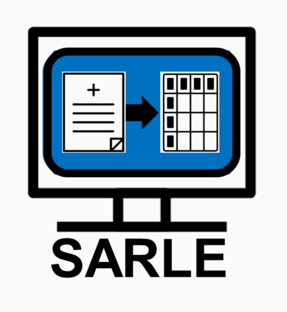This is the Python implementation of Sentence Analysis for Radiology Label Extraction (SARLE), a method to automatically extract structured labels from radiology reports. SARLE achieves an average F-score of 0.976 (min 0.941, max 1.0) when evaluated on the RAD-ChestCT dataset of chest CT reports.
The SARLE method is described in our Medical Image Analysis paper, which is also available on arXiv.
If you find this work useful in your research, please consider citing us:
Draelos, Rachel Lea, David Dov, Maciej A. Mazurowski, Joseph Y. Lo, Ricardo Henao, Geoffrey D. Rubin, and Lawrence Carin. "Machine-learning-based multiple abnormality prediction with large-scale chest computed tomography volumes." Medical Image Analysis 67 (2021): 101857.
The requirements to run SARLE are listed in requirements.txt.
One of the goals of SARLE is to have minimal dependencies.
To run all the code in this repository, only 6 packages are required:
- numpy and pandas for SARLE data handling
- scikit-learn for performance metrics
- matplotlib and seaborn for visualizations
- fasttext for SARLE-Hybrid
Newer versions of these packages will almost certainly work. The versions in the requirements.txt file simply represent one configuration that works for this codebase.
SARLE-Rules can run on any operating system (Linux, Mac, Windows, etc.)
SARLE-Hybrid can only run on Linux or Mac, as the fasttext package is not available for Windows.
To run a demo of SARLE-Rules and SARLE-Hybrid on the public OpenI dataset of chest x-ray reports, run this command:
python demo.py
To deploy SARLE on your own dataset, we recommend using SARLE-Rules rather than SARLE-Hybrid because:
- you won't need the fasttext dependency;
- you won't need to do the manual sentence labeling fasttext requires;
- SARLE-Rules outperforms SARLE-Hybrid in our experiments.
demo.py includes a demo on real data and fake data.
- real data: SARLE is demonstrated on the OpenI dataset of chest x-ray reports.
- fake data: SARLE is demonstrated on some tiny handcrafted dataframes of fake data, to demonstrate the data format.
train_data
- In SARLE-Hybrid, the train_data is used to train the sentence classifier. In order to train a sentence classifier, the sentences in the train_data must be labeled with 1 (abnormal) or 0 (normal) if they describe abnormal or normal radiologic findings, respectively. If you do not want to spend time manually labeling sentences, just use SARLE-Rules.
- In SARLE-Rules, the train_data may be used by a human to create custom rules. When running SARLE-Rules as-is, the rules that were already created will get applied to the train_data, because if we have the end goal of training a computer vision classifier we still need to have labels for examples in our train_data set. For SARLE-Rules, train_data does not need any manual sentence labels.
- If you just want to quickly try out SARLE-Rules on a sample of your own data and look at the output, you can put your sample data in as the train_data in the fake data demo.
test_data
- The test_data is used to calculate SARLE's performance predicting abnormality labels.
- To calculate SARLE's performance on your own dataset, in addition to providing a train_data dataframe, you must also separately provide a manually generated report-level abnormality ground truth for the reports in the test_data set.
- To see an example of the required abnormality ground truth format, you can look at the output of load.load_ground_truth('openi_cxr').
- You can see an example of abnormality ground truth being used in performance calculations in the function eval_on_report_level_ground_truth() in evaluation.py.
- If you provide a test_data dataframe but don't provide an abnormality ground truth, then SARLE will simply skip the performance calculation step.
predict_data
- The predict_data is optional. It consists of additional radiology reports on which we might want to deploy SARLE to obtain abnormality x location labels, e.g. as part of creating a large dataset to train a computer vision classifier.
- predict_data does not need to be manually labeled in any way. It does not need to have binary sentence labels and it does not need to have report-level abnormality labels either.
- It is OK not to have a predict_set. If you don't have a predict_set then you must set the predict_set to pd.DataFrame() (an empty dataframe).
If you would like to customize the normal/abnormal phrase classification step of SARLE-Rules, you can edit the rules in:
- src/rules/rules_ct.py
- src/rules/rules_cxr.py
You should only use the training set when generating rules.
SARLE presently focuses on chest abnormalities, but does include some abdomen, pelvis, and general abnormalities. If you would like to customize SARLE's abnormalities, you can do so by editing the vocabulary files:
- src/vocab/vocabulary_ct.py
- src/vocab/vocabulary_cxr.py
If you would like to customize SARLE's locations, you can do so in
- src/vocab/vocabulary_locations.py
Similarly, you should use the training set to generate vocabulary rules.
An earlier version of this repository contains the original SARLE which produces predictions of abnormalities only.
The current version of this repository is a more advanced version of SARLE that produces predictions for both abnormalities and their locations. As far as we are aware, SARLE is the only radiology label extraction software to produce both abnormality and location predictions. For each radiology report, an abnormality x location matrix is produced specifying every abnormality identified and its location (e.g. nodule/right upper lobe of the lung, mass/left lower lobe of the lung, nodule/liver). Location identification is done in a rule-based manner.
To run the unit tests, run this command:
python -m unittest discover
The SARLE logo includes Creative Commons icons from the Noun Project: computer, report, and table.
